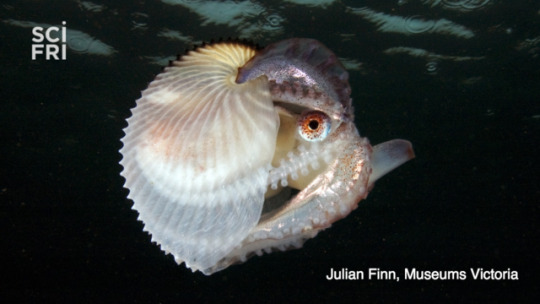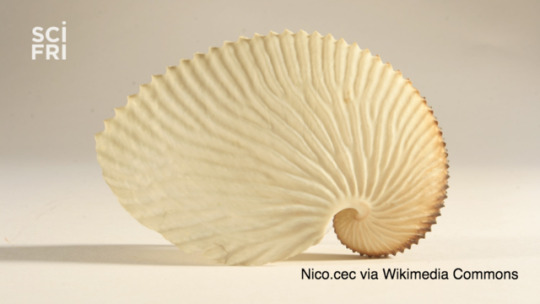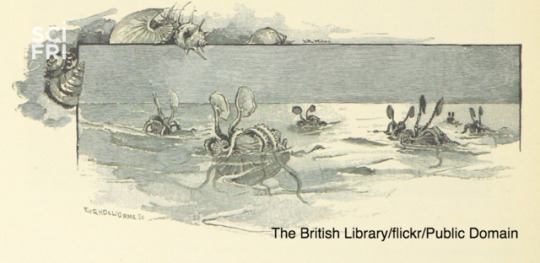Science, technology, and other cool stuff from the folks behind public radio's Science Friday. It's brain fun, for curious people. From WNYC Studios.
Don't wanna be here? Send us removal request.
Video
youtube
Every scientist's journey is unique. Paleontologist Jingmai O'Connor grew up surrounded by science–her mom was also a scientist. But her fascination for Mezosoic avian dinosaurs and bird evolution was a convergence of both curiosity and heritage.
"This would be a way of combining my love of China and Chinese culture with paleontology, my new fascination and obsession." Watch her story at breakthroughfilms.org.
When paleontologist Jingmai O’Connor looks at the abdomen of a small, ancient avian fossil, she gets a thrill when she spots a jumble of nodules, no bigger than a scattering of goosebumps, protruding from the creature’s bones. Their presence could mean the animal’s metabolism supported rapid egg growth. In another specimen, O’Connor discovers an entire bird gobbled up inside of a chicken-sized feathered dinosaur, revealing a clue about the ecology in which both animals lived.
O’Connor’s obsessive eye for detail and encyclopedic knowledge of morphology comes in handy when she’s placing these fossils on the ancient family tree of birds. She credits those skills, as well as her enthusiasm for science, to her mother, a geochemist who earned her PhD while raising O’Connor and her three siblings. It was also her mother’s influence that led O’Connor to focus on geology—and to explore her own Chinese-American roots—by focusing her studies on the scores of bird fossils coming out of China at the turn of the century.
Dozens of discoveries later, O’Connor is now a professor at the Institute of Vertebrate Paleontology in Beijing where she uses the world’s largest collection of avian dinosaurs to explore the changes in ancient species that led to wings, tail feathers, flight, and many other adaptations seen in modern birds.
#women in science#women in STEM#breakthroughfilms#paleontology#bird evolution#dinosaurs#dinosaur evolution
25 notes
·
View notes
Video
youtube
Meet volcanologist Kayla Iacovino.
Part science-fiction sleuth, part mountaineer, Kayla works to unearth the mysteries deep within volcanos on Earth and in space! So how does her love of ‘Star Trek’ fuel her passion for science?
MORE ABOUT THIS EPISODE
When volcanoes erupt, gases blast from the earth in fast-moving pyroclastic flows destroying everything in their path. Torrents of molten magma create new landscapes. Massive calderas launch explosive boulders miles away.
But how do these destructive forces work? Scientists don’t have a full picture yet. It is currently impossible to fully understand the geochemical forces that lead to these destructive scenarios. But what if we could unravel this mystery by examining millennia-old cooled rocks and soils from these same eruptions?
Kayla Iacovino—part science fiction sleuth, part mountaineer—is doing just that. By hiking mountainous terrain or meandering through a city built on a dormant volcanic crater, the volcanologist collects rock samples from across the world in order to better understand the forces that created them.
At her experimental petrology lab at Jacobs-NASA Johnson Space Center, she subjects these samples to extreme pressure and temperature in “mini magma chambers” to recreate the conditions under which they formed. Ultimately, understanding how the molten materials deep within the Earth became rocks provides Iacovino insights about the overall geological makeup and origins of Earth.
38 notes
·
View notes
Video
youtube
We are so excited to unveil the latest season of Breakthrough, a short film anthology from Science Friday and Howard Hughes Medical Institute (HHMI) that follows women working at the forefront of their fields. Breakthrough hopes to inspire a future generation of women to lead careers in STEM. New episodes drop weekly OR catch the entire series now on Alamo On Demand.
Learn more at BreakthroughFilms.org. If you are an educator or career counselor, don't forget to check out the Breakthrough Inclusive Action Tool Kit.
#women in science#women in STEM#paleontology#neuroscience#volcanology#astrophysics#astronomy#geoscience#earth science#biology
30 notes
·
View notes
Text
If you smelt it, the corpse flower dealt it.


Listen along on our field trip to the New York Botanical Garden and our encounter with the mighty corpse flower.
All photos by Daniel Peterschmidt
105 notes
·
View notes
Photo

Whales are majestic, awe-inspiring animals. Some species can reach up to 150 tons and take in a living room-sized volume of water in one gulp. They can even dive thousands of feet into the ocean while holding their breath all the way down. But these traits are also why whales are a mystery to scientists. It’s hard to imagine that the earliest ancestors of these graceful creatures of the deep were four-legged dog-like animals that lived on land.
In his book Spying on Whales: The Past, Present, and Future of Earth’s Most Awesome Creatures, paleontologist Nick Pyenson examines the fascinating features of these animals—from their enormous size, echolocation abilities, and specialized feeding behaviors—and how they can be used to piece together the evolutionary story of whales. Tune in to today’s show at 2pm ET for our wrap up of Oceans Month!
Photo by Smithsonian Institution Archives/Public Domain
46 notes
·
View notes
Photo

In 1995, a loggerhead turtle named Fisher washed ashore in North Carolina. He was too weak to swim back out to sea solo, so researchers and various institutions cared for him. A decade later, Fisher had grown to a hearty 150 pounds. It was time for him to go.
Researchers generally believe that baby loggerhead turtles born in the western Atlantic hitch a ride via the Gulf Stream to the eastern part of the sea, and hang out there for 10 to 15 years before making their way back to their hometown. It remains a mystery exactly why the turtles return, but Lucy Hawkes, an animal migration researcher and senior lecturer in ecology at University of Exeter, guesses that it’s an evolutionary tendency—the turtles sense that if they themselves were born in a certain place, it must be a safe place for them to have their own babies.
When Fisher was released, Hawkes expected him to follow that path and allow the Gulf Stream to carry him across the sea. Instead, he bee-lined straight across the ocean towards the eastern Atlantic (as indicated by the purple line on the map above).
“It was like he was playing catch-up in a race,” Hawkes says. “Think of it as a running race around the side of the field. When the race started, Fisher was too busy doing his shoes up or something, and then halfway through the race he thought, ‘Oh god, I better catch up with everybody else!’ and then ran straight across the field rather than around the side of it like everyone else did.”
She had never seen this kind of path before. But Fisher’s case isn’t the only mystery of turtle migration. Hawkes is doing constant sleuthing for migration mysteries: “It’s like being a real-life detective of animals.” Read more about the stories locked within maps here.
All map images reprinted from Where the Animals Go: Tracking Wildlife with Technology in 50 Maps and Graphics by James Cheshire and Oliver Uberti
110 notes
·
View notes
Photo



The argonaut octopus, of the family Argonautidae, belongs to a group of pale pink-spotted octopuses. Unlike the heroes that sailed the Argo in the Greek myth, these octopuses are known for traversing the open ocean by way of a delicate, curved, creamy white vessel—an external casing, often referred to as a “shell,” that gave them their common nickname, the “paper nautilus.”
These creatures baffled naturalists and philosophers for two millennia, even fooling Aristotle, who believed that they used their large pair of webbed dorsal arms as “a sail” to catch the briny breeze and floated across the ocean’s surface like paper boats. These myths carried weight for centuries, even among naturalists in the 19th century.
It wasn’t until the early 1830s when self-taught French naturalist, Jeanne Villepreux-Power began researching the Argonauta argo, or the greater argonaut, that we learned the true origins of their “shells.” Along the way, Villepreux-Power tried new methods for studying sea creatures that gave insights not just into the paper nautilus, but also helped us to better understand other creatures of the sea today. Meet the “mother of aquaria.”
1K notes
·
View notes
Photo



The scene begins innocently enough. An unsuspecting pearl fisher paddles through the water, going about his business. Waves gently buffet the diver as he nears a coral reef, and crabs scuttle into their holes. Then, a single sinewy arm of an octopus snakes through the water, closing in on the diver.
The scene from the 1916 film 20,000 Leagues Under the Sea was shocking to audiences. “Undersea filmmaking pioneer” John Ernest Williamson reflects on the scene that he helped create: “The [sight] of that great pulpy body, those great staring eyes, those snake-like sucker-armed tentacles [sic], sent a chill of horror down my spine,” he writes in his memoir 20 Years Under the Sea. “The giant cuttle-fish glided with sinuous motion from its lair. Loathsome, uncanny, monstrous, a very demon of the deep, the octopus was a thing to inspire terror in the stoutest hearts.” (While Jules Verne’s original novel often features a giant squid when translated into English, Williamson refers to his creation for the 1916 film as an octopus.)
Moviegoers were held rapt as Captain Nemo dove into the water and battled with the impossibly large cephalopod, eventually hacking off one of its writhing arms, freeing the pearl fisher, and fleeing in a cloud of the creature’s ink. They were sucked in not only by the terror it inspired but also by its technical innovations. The battle, and great octopus, was the centerpiece of the first major motion picture to be filmed underwater. Read more about this octo-film here!
144 notes
·
View notes
Photo




Bret Grasse lovingly calls the Cephalopod Operations division at the Marine Biological Laboratory (MBL) in Woods Hole, Massachusetts the “cephalopod empire.” The lab houses roughly 2,000 to 3,000 cephalopods—likely the largest collection of cephalopods of any research laboratory. But it might not be that way for long, if Grasse and MBL have their way. They hopes that one day, these creatures will be as ubiquitous in labs as mice or fruit flies.
“There’s no other invertebrates on the planet that can do what these animals can do,” Grasse says. “They’ve got three hearts, and mini brains at the base of each of their arms capable of movements on their own, abilities to edit their own RNA, and very complex cognition.”
Because of this, cephalopods can provide unique experimental value to scientists, such as the potential study of senescence in mother octopuses as way of investigating neurodegenerative diseases. MBL selected five candidate species to be the next top model organism. Meet them here!
167 notes
·
View notes
Photo



Life is hard for the mighty cephalopod. “If you’re a cephalopod, you’re super easy to eat,” says Sarah McAnulty, a squid biologist. “You’re basically a swimming protein bar.”
She studies a species of cephalopod called the Hawaiian bobtail squid. While most cephalopods have flashy adaptations to stay off predators’ dinner menus this particular squid relies on something that many other cephalopods don’t—its bacteria BFF.
Although some invading bacteria are destroyed by cells within the bobtail, their immune systems can learn to recognize “beneficial bacteria,” or bacteria that is ignored, and may even receive help from the immune system if it proves helpful to the livelihood of the animal. Learn more about the Bobtail squid’s BFF in the latest Macroscope video!
501 notes
·
View notes
Photo

CEPHALOPOD WEEK IS HERE! And on June 18 to 21, Cephalopod Movie Night is coming to a city near you!
Citizens beware! Cephalomania is sweeping the nation!
Cephalopod Week is back and Science Friday is teaming up with Atlas Obscura for a series of ceph-centric events stretching across the nation! In each city we’ll screen four short films produced by Science Friday, followed by conversations, performances, activities, and other geeky fun. Find out if the tentacled madness is coming to your city, and grab your tickets before they wind up in someone else’s arms!
481 notes
·
View notes
Photo



Meet “Baby Groot.”

He’s a tiny settled coral named after the character from Guardians of the Galaxy. Spawned from coral in Key Largo, Florida, he has been slowly growing on a tile disc for about nine years. A team of biologists regularly examine the color of his tissue, the number of polyps, and any signs of encrusting along the settlement—a good indication of growth.
“He looks really, really good right now,” Kimberly Stone says. “He looks beautiful today, actually.”
And when he’s big and healthy enough, he’ll eventually be nudged out in the big, wide ocean.

Baby Groot is one of the corals grown in a lab at Georgia Aquarium in Atlanta, Georgia. As curator of fish and invertebrates, Stone not only helps craft galleries of sweeping habitats akin to the sea floor, but also heads up the coral propagation and restoration efforts at the aquarium. Currently, there are around 550 reef-building corals in oceans worldwide—a number of which are at risk of bleaching. Stone and her team bring in their years of practice working with marine habitats to cultivate and care for developing corals in the lab and transplant them back into reefs in the wild. Learn how the researchers grow coral in this Macroscope video.
239 notes
·
View notes
Photo



Meet the sub pilot who helps film Blue Planet.
You’ve likely seen some amazing underwater documentary footage from places like BBC’s Blue Planet and Discovery Channel. But have you ever wondered about the submarine pilots who make that footage possible in the first place?
Meet Mark “Buck” Taylor, the sub team leader for the research and exploration vessel Alucia. Buck is responsible for carrying out all the submersible operations aboard the ship. The Alucia facilitates missions for both scientific research and serves as a home base for documentary productions like Blue Planet.
Buck started his career far away from cameras as an explosive ordnance device diver for the British Navy. After that, he was a submarine rescue pilot and transitioned to documentary and scientific research.
We sat down with him to talk about what it’s like doing science at the bottom of the sea, capturing the first footage of a living giant squid, and how the ocean still amazes him. Read the interview here.
Photos courtesy Buck Taylor
68 notes
·
View notes
Photo

Summer is almost here. That means it’s time to dust off those binoculars.
The days may be getting longer, but the nighttime sky is still just as bright. It’s time to haul out those old lawn chairs, rustle up a pair of good ‘ole binoculars, and stretch out beneath the twinkling summertime sky. Dean Regas, outreach astronomer at the Cincinnati Observatory, co-host of the PBS series Star Gazers, and author of the book 100 Things To See In The Night Sky, is here to give us a guide to the summertime skies.
Photo by Dualiti Photos/flickr/CC BY-NC-SA 2.0
69 notes
·
View notes
Photo




To the untrained eye, it might look like a pleasant stretch of the Long Island Sound off the coast of Connecticut. But Suzie Flores sees a side gig—and the future of American agriculture.
“It’s farming, just like somebody who has a tomato farm or vegetable garden,” she says. “It’s just I do it out on the water instead of on land.”
Flores is a kelp farmer. She heard about growing sea vegetables for food (which is common practice in Asia) and wanted to try to grow some for herself—because kelp is what’s for dinner. Learn more about the U.S. kelp farming business in the latest Macroscope video.
288 notes
·
View notes
Photo

You may not know it, but you have a deep relationship with the ocean. Covering about 70 percent of Earth’s surface, the ocean helps regulate the planet’s climate, provides millions with a livelihood—not to mention it is the source for almost half of the oxygen you breathe. As marine biologist and explorer Sylvia Earle says, “With every drop of water you drink, every breath you take, you’re connected to the sea. No matter where on Earth you live.”
Yet, despite the significant role it plays in our lives, we only know very little about the ocean. Beneath the vast surface there’s a wild ecosystem—an estimated 91 percent of marine species are yet to be identified, and scientists have charted more of the moon and Mars than the topography of the ocean, for example.
That’s why, throughout World Oceans Month this June, we’ll be exploring the science beneath the waves—from journeying to the ocean floor with deep sea researchers, to swimming alongside some of the most surprising animal migrations on the planet, to exploring the invisible forest churning oxygen just below the waves, to resurfacing classic interviews from the SciFri archive, and more.
Take a deep breath and dive in. We’ve got a lot to explore.
Welcome to Oceans Month.
45 notes
·
View notes